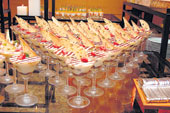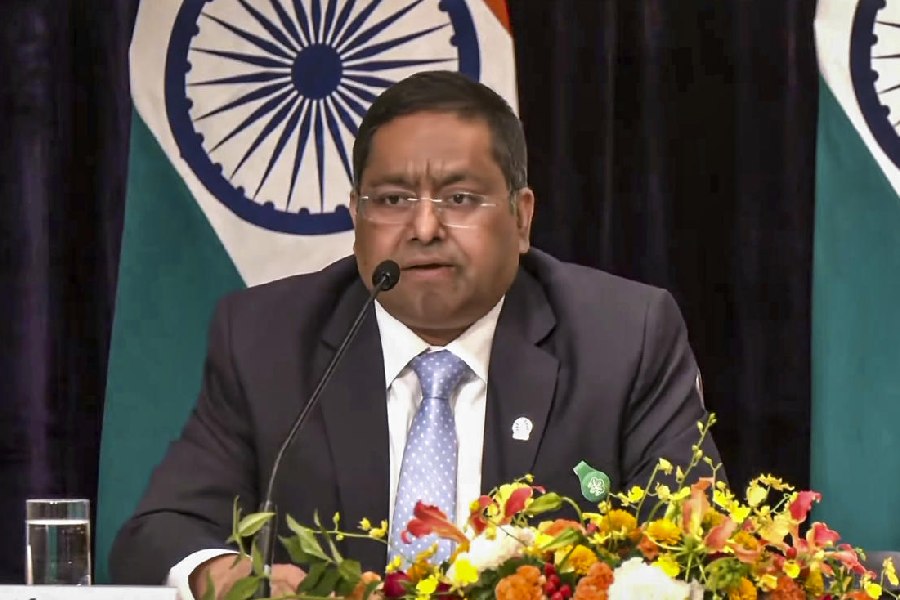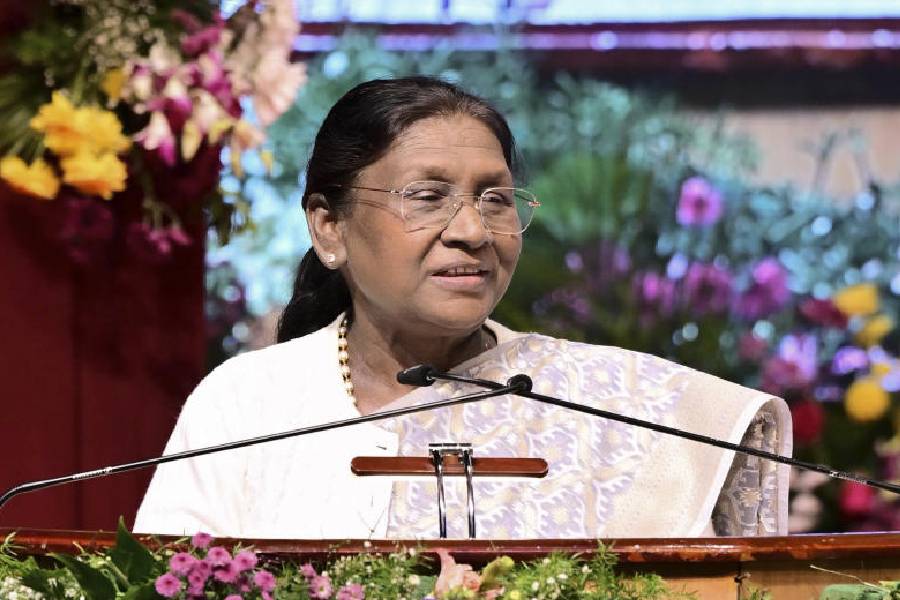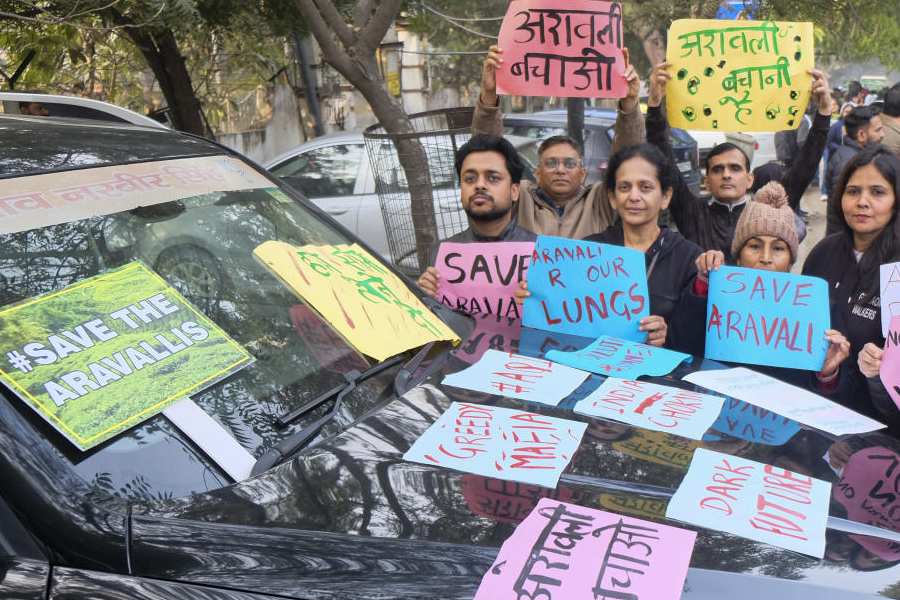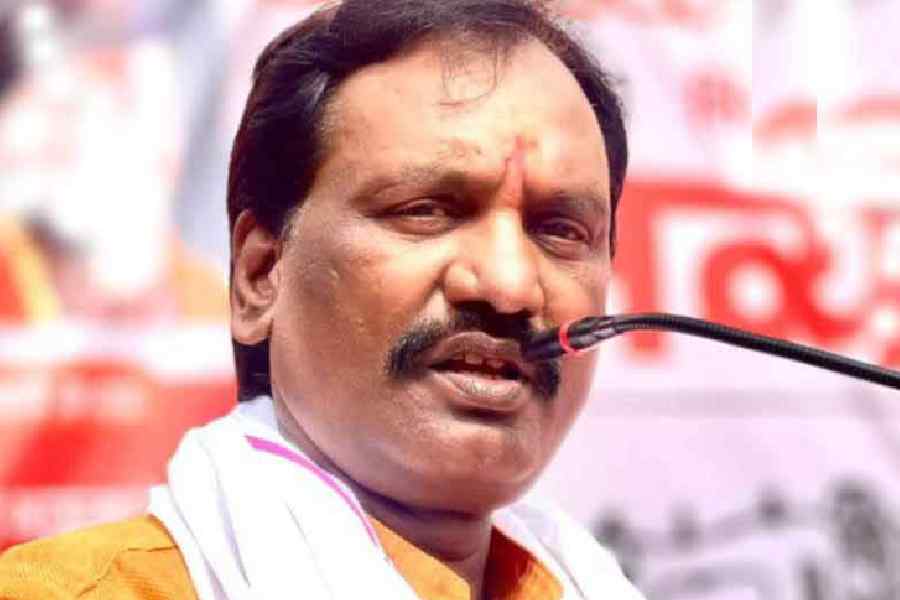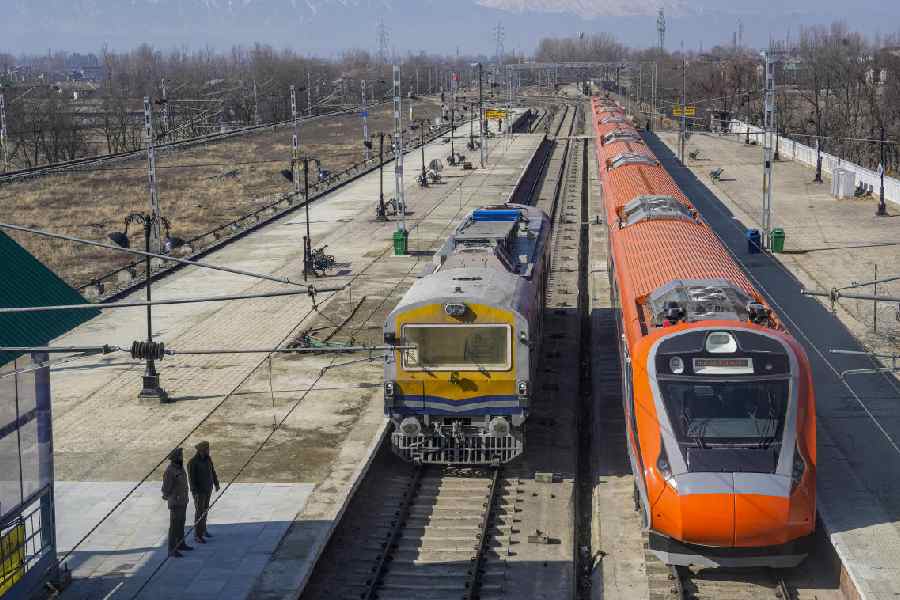 |
 |
| (From top) Exotic desserts from the kitchens of the Grand Hyatt hotel in Mumbai; a salad bar at a reception planned by Wedding Xtra Ordinaire |
Will it be caviar flown in from Dubai or London? Or, will it be a teppanyaki chef putting on a special display at a live counter? And what about Korean or Mongolian-style cuisine if you really want to add new flavour to the proceedings?
How do you stay one step ahead in the Great Wedding Game? You’ve got to splash, to have the biggest and grandest nuptials that will be remembered for the rest of time — or, at least, talked about for the rest of the season. Yes, the decor is important and so are the spectacular outfits worn by the bride and groom.
But, as Napoleon once said, an army marches on it stomach, and nothing’s more important than the tables groaning with the most exotic foods that money can buy. To add to the performance the chefs (preferably celebrities in their own right) must be whipping up colourful dishes before everyone’s eyes.
“If it has to be The Wedding in town, the food is central. People actually count the number of items, the taste and even the presentation of the food,” says wedding planner Vinod Bhandari of Wedding Xtra Ordinaire.
But the food scene is competitive so it’s important to be one step ahead of the Singhs, the Kohlis and the Chatterjees. And you’ve got to have exotic dishes that nobody has even dreamt of before.
International cuisines are big in the wedding circuit this season. For a start, think Oriental. Think Vietnamese, Mongolian and Korean, not the clichéd Chinese and Thai of yesteryears. Or for that matter Italian, which is still high up on the charts for weddings.
All the way from New Orleans, there’s spicy, Cajun food such as Jambalaya and barbecued shrimp. To be out-of-the-box, you can even try out German cuisine with its spicy sausages, salads and soft breads. And have you ever heard of the Brazilian grill (it’s said it can cook any kind of meat from crocodile to deer)?
Wedding caterer Navin Pai (of Pai Foods) likes to keep it light and healthy, keeping in mind the fact that several weddings usually take place in a row. “The stomach of the wedding guest has to bear the brunt. So instead of curries, we will do a lot of stir-fries. Also you will see Japanese cuisine with teppanyaki and sushi,” explains Pai. His signature dishes: the water chestnut (steamed panifal coated with soya sauce, garlic and tossed in an Oriental sauce) and the Aloo Tak (mashed and oven- roasted baby potatoes).
One good thing about Indian weddings is that they usually go on for days and there’s plenty of time to try out different types of cuisine. The tempo builds up from the bachelor and hen nights to the wedding and ends finally with the grand reception. From flair bartenders dazzling the wedding guests with their heady concoctions at the cocktail bar to chefs dishing out authentic teppanyaki live or expensive caviar counters, there are scores of ways to impress le haute monde.
You could, of course, stay firmly rooted in Indian soil and still be a worldbeater when it comes to exotic appeal. The charm of regional cuisines is undeniably too attractive to exclude them from the wedding. Executive chef Gautam Mehrishi of Mumbai’s Sun ‘’ Sands hotel, which has played host to a number of celebrity weddings including those of Karisma and Riddhima Kapoor, charts out a menu where he includes Dum Ki Biryani and Gucchi Dum Pulao (an exotic mushroom dish).
 |
 |
| A Rajasthani theme wedding reception organised by Wedding Xtra Ordinaire; a chef (above) at the Grand Hyatt, Mumbai adds the finishing touches to a dessert counter |
For the ubiquitous dal, he recommends a live station. “You can add North Indian style tarka or a South Indian style tarka to your dal and garnish with a dollop of butter or ghee,” he elaborates. In the meat section, he has some mouthwatering dishes like Sauf Elaichi Ka Gosht, Tamatar Machchi, Murg Makhan Palak and Murg Methi Chaman amongst a host of others.
Now you might have always associated South Indian cuisine with masala dosas and idlis. But sous chef Anish Padgaonkar of Grand Hyatt, Mumbai, has Mangalorean and Kerala cuisines to offer from the south.
From the north, he highlights Kashmiri cuisine with dishes such as Tabakmaaz (lamb ribs fried in ghee), Roganjosh (lamb in red curry), Gushtaba (meat balls in yoghurt curry), Nadr Yakhn (lotus stems in yoghurt), Fhirun (semolina and milk pudding) and Shufta (chenna and dry fruits dessert).
The emphasis on regional cuisines is also big at Calcutta’s ITC Sonar Bangla where Shweta Mishra, the assistant banquet manager, puts together the fare along with the chef. While last winter they organised wedding banquets on Moroccan and Roman themes, this time it is going to be on Mithila and the Northern Frontier.
For those who haven’t had it before, Maithili cuisine includes authentic non-vegetarian fare with mutton dishes spiced up generously by the addition of hing (asafoetida) and tamarind. For North Frontier cuisine, Sonar Bangla will have live stations — with the Dum Pukht counter dishing up tawa kebabs, the Peshawari counter serving food straight from the tandoor and the Punjabi counter with Sarson Ka Saag, and Makke Ki Roti.
“The trend in all these cuisines is to fly in chefs across the country — chefs who are known for their signature dishes. We also recreate the look likewise at the wedding venue. The costs significantly go higher, ranging from Rs 3,500 to Rs 4,000 per person,” says Bhandari.
But take note: The live station is indispensable. For instance take the lavish fare that chef Anish Padgaonkar dished up for actor Fardeen Khan’s wedding. The special feature was a live grill station that had Teriyaki sauce with chicken breast, lamb chops and parsley potatoes, among other delicacies. There were several more live counters that included everything from raita, to pasta, risotto and ice cream stations.
“Here’s a chance to play with taste, variety and colour. It’s as interesting as having a live band play for you. And there is all the opportunity in the world to be your own chef. At the end of the day, we all like to think of ourselves as culinary experts,” says Mehrishi.
For the uninitiated, the live station is a counter where food is made in front you fresh and served warm. Of course, it is food that can be prepared easily and does not take too much time to dish out. There can be different kinds of live stations like bread stations, sundae stations, gol gappa and paapri chaat counters. A live counter rustling up vegetarian dishes charges Rs 250-300 per person, while one dishing out non-vegetarian delicacies comes to about Rs 500 per person.
“The focus of it is to make the counter unusual and add flair for visual appeal. For instance, there can be pizza stations where the chef can toss pizzas in the air for that extra effect and malabari parantha stations where the paranthas are made with great flamboyance,” says food consultant Marut Sikka. “For innovative ideas, you can try an interactive salad station where fresh ingredients can be tossed together or even a steam counter where every item is served steamed. What’s more these are healthy as well.”
Looks count for a great deal when it comes to feasting. Ranvir Bhandari points out that everything from the spoons to the dishes must be special. “But there is a special way of serving caviar in gold-plated glitzy bowls accompanied by crystal goblets,” says Bhandari who set-up up caviar counters at Vanisha Mittal’s reception at Lakshmi Mittal’s Alipore bungalow. Bhandari gets a special salt-free sparkling gold variety of caviar called the American Gold Caviar from the US, the Grand Passion Caviar from the Middle East and the Dessert Caviar from Venezuela.
But scale is also equally important at a Great Indian Wedding. Traditionally weddings are pure affairs, points out Sikka. He says, “In rural north India, they serve wedding food at the langar in the gurudwara during weddings and in South India, you are served on banana leaves. But with time, the elite few have decided on extensive weddings that boast above 40-45 dishes.”
But how grand does grand get? According to Bhandari, an exclusive affair could include 300 food items and five to seven live counters with paanwallas brought in from Varanasi, kulfi and falooda makers from Jodhpur, chaatwallas from Delhi and Haagen-Dazs ice cream. And a flair bartender at the bar would come to around Rs 25,000-Rs 30,000 for the bartender alone.
Getting food imported is a big favourite for those who can afford it. “Especially meats like parma ham, German black forest ham, breads and different kinds of cheese,” says Madhurima Sinha, PR director, Taj Bengal. Meanwhile at Sun ‘’ Sands, Mehrishi likes to import fruits ranging from Nordic and Pacific Rose apples (United States), green apples (Germany), Californian grapes and oranges, golden and green kiwis (New Zealand), to litchi-like fruit such as Mangosteen and Ramboutan (Thailand).
If the cost factor escalates what with imports and live counters, there are also the other details such as the presentation of food that have to be looked at minutely. Says Bhandari, “There is great stress on the layout of the table, the waiters doing the serving and paying personal attention to the wedding guests. With all these factors involved, the sky is the limit when it comes to loosening the purse strings.”
But then, it’s that day you are going to look back on for the rest of your life. So you’ve just got to serve up the very best that money can buy.
D-day checklist
Things to be kept in mind while planning that wedding menu:
• Keep the season in mind while deciding the menu. Great chefs plan the menu around whatever is fresh.
• Get your numbers right. To narrow down on options and help you determine the right cuisine, you need to find out about the crowd profile.
• Go for variety. To cover a wide variety of palates, keep an array of non-fried, spicy and fried dishes.
• At least 50 per cent of the food should be interactive.
• Keep a strong eye on colours, textures and display.
• Cuts of meats and vegetablez have to be different.
• Do not repeat ingredients, or for that matter, words in the menu, cuisines and even the style of cooking.
• Make sure everything is hygienic. After all, a wedding is a big affair and you do not want upset stomachs the next day. Chef Mehrishi remembers a Delhi wedding where someone came into the cooking area to check whether the water taps had muslin cloths tied to them.
• And as Marut Sikka says, try to go for locally available meats. Imported stuff is always frozen and old. So keep it fresh.

